This post may contain affiliate links. If you click on one and purchase something, I may receive an affiliate commission — at no extra cost to you.
If you’ve been a regular reader, you know that I had some troubling experiences with sexual harassment in Kathmandu. It’s colored my perception of Kathmandu, but objectively, the city has some amazing cultural and historical sites that are definitely worth a visit. Plus, if you arrive in Nepal by air, you’ll most likely land in Kathmandu, so you might as well as check it out. Here’s my list of the best things to do in Kathmandu.
1. Visit the Kathmandu Durbar Square
Perhaps the most famous site in Kathmandu, the Durbar Square in the nation’s capital is a shadow of its former stature thanks to the April 2015 earthquake.
But this UNESCO World Heritage Site is still worth the 1000 Nepalese rupees (NPR) it costs to visit, and it’s a fantastic introduction to Nepal and its many cultures.
There are so many fascinating things and people to see just by walking around and checking out all the parts of the square (…including some NSFW aspects).



To me, there were two learnings that were more fascinating than anything else.
- Did you know that Nepal was a monarchy until 2008? The story of how the monarchy ended is even more fascinating, as is part of the Nepali population’s belief that the monarchy will return (and would be better for the country).
- Hindus in Nepal worship the Kumari, a pre-pubescent girl seen as the manifestation of the divine female energy. Known as the Living Goddess, the Kumari is chosen at a young age from a certain caste and lives mostly in elevated isolation until she hits puberty, at which point she is no longer the goddess and a new manifestation is chosen. As the Kumari is sacred, there is strict policing in her temple to make sure no one takes any photos of her during the few times each day when she appears at her window. I saw the current Kumari briefly and couldn’t help but wonder what her childhood is like, all closed off from the world.


There are tons of certified guides roaming the Kathmandu Durbar Square offering their services for around 500 NPR per hour. I happened to pick up this abandoned Lonely Planet guidebook at my hostel and wasn’t particularly feeling like I wanted to talk to anyone, so I forewent the guide.
But I would actually recommend having one as there’s so much historical context, plus cultural annotations, that you can’t get just by walking around. After all, the place is still under reconstruction.
2. Eat a ton of momos
To me, momos are perhaps the representative of Nepalese cuisine. But then again, my exposure to Nepalese food was rather limited before I went to Nepal.
Momos are incredibly cheap and delicious, averaging around 10 for 100 NPR, or roughly $1 USD. And I love any sort of dumplings, so believe me, I had a ton of them.
Buffalo momos, beef momos, chicken momos, spicy momos, stir-fry momos.
Mo’ momos, please!
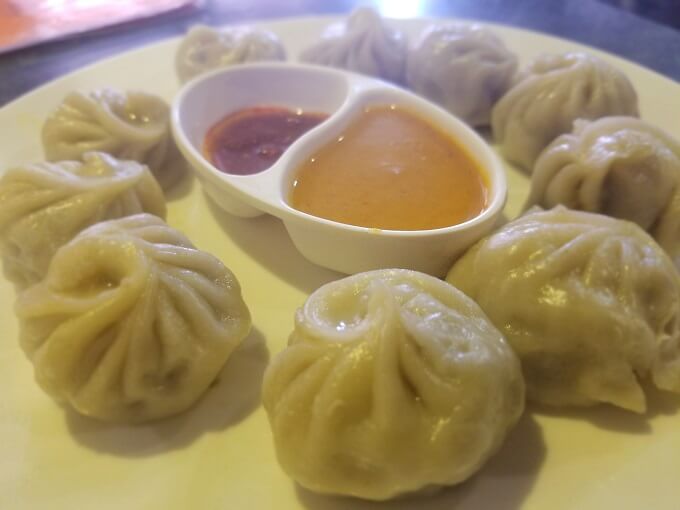
3. Try other Nepalese foods, too
Of course, don’t stop at momos.
Nepalese cuisine is very much inspired by its many ethnic groups and its neighbors, and it can vary, so make sure to try other Nepalese foods as well.
Some must-tries (pictured below, clockwise):
- Dal bhat, a trekker favorite (~300-500 NPR per platter off the trail, ~500-800 NPR when trekking)
- Newari desserts such as the yomari. It’s a steamed dumpling with different types of sweet, liquidy fillings. (~50-60 NPR each)
- Nepalese chow mein (~100-150 NPR per heaping plate)
- Sel roti, which is like a funnel cake but better. Basically a rice flour donut. (~10-15 NPR each)
- Lahping, a cold dish of Tibetan origin that’s made of spicy mung bean noodles. Because it’s street food that’s a cold dish, many people don’t try lahping due to questionable food hygiene practices by street vendors. (It is true that I saw no running water or gloves in use.) But tried it and am still alive! (~40-50 NPR per small bowl)





4. Get a little drunk on Nepalese booze
While we’re at it, make sure you try some Nepalese alcohol as well.
Namely, raksi, the distilled liquor made from fermented rice or millet that’s closely related to Bhutanese ara. This often homemade drink tastes a bit like sake.
The other main Nepalese drink to try is their homebrew — chhaang (chang, chhyang, and other similar spellings). Barley, millet, and/or rice are used to ferment this drink, and it’s often served at room temperature.
If traditional beer is more your style, make sure to try Gorkha, Everest, Nepal Ice, and Sherpa Brewery, among others.
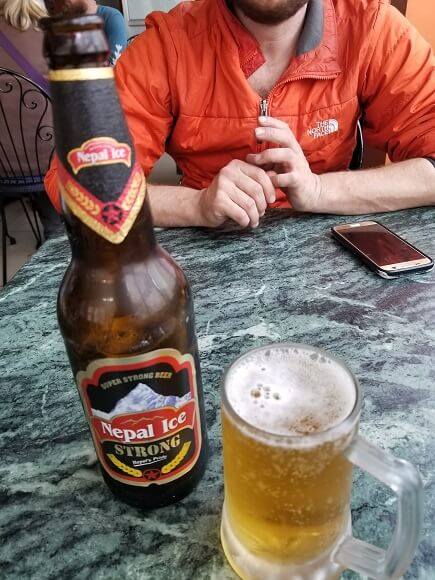
5. Explore the Patan Durbar Square
I know, I know. I went from one Durbar Square through a lot of food and drink and brought you straight back to another Durbar Square.
Durbar Square basically refers to plazas across from royal palaces. Before Nepal was one unified country, there were many smaller kingdoms that each had their own rulers and royal palaces.
In Kathmandu Valley, there are three famous Durbar Squares: that of Kathmandu, this Patan one, and the one in Bhaktapur.
Since I travel mostly by public transit and by foot, I chose to visit Patan Durbar Square as I could walk to it from Kathmandu.
The walk is roughly 4.7 kilometers, or ~2.9 miles, and takes around an hour. It’s a nice way to explore neighborhoods outside of the main tourist hotspots.
Admittedly, the pollution in Kathmandu is the worst I’ve ever experienced and isn’t great for the lungs, so make sure to buy a good mouth mask before your walk. If you’d rather get a car, it’s roughly 300 NPR for a taxi between Kathmandu and Patan.
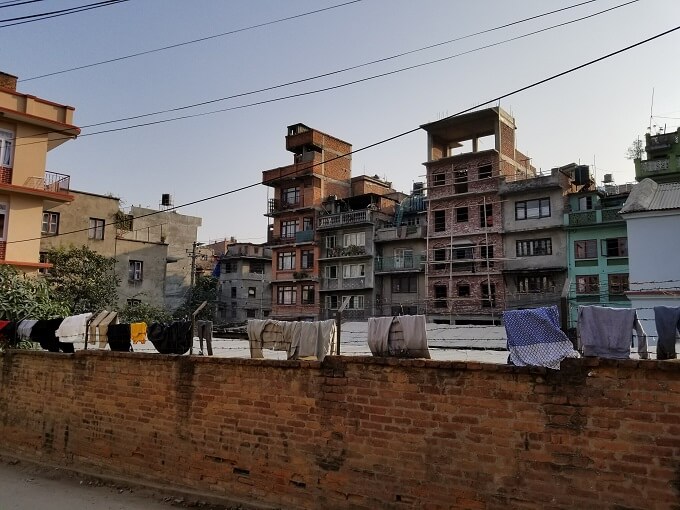
Like the Kathmandu Durbar Square, the Patan Durbar Square was also damaged by the 2015 earthquake, though perhaps less extensively so. Because of this, there’s quite a bit more to see and learn from in Patan.



The 1000 NPR ticket includes admission to both Patan Durbar Square and the Patan Museum, the latter of which should not be skipped.
Pro tip: If you’re on the taller side, just make sure to watch your head as you explore the museum and the various buildings open to visitors. The doorways are all super short!
6. See the eye at Boudha Stupa
Okay, two more walkable spots coming your way.
First, Boudha Stupa, or Boudhanath.
One of the largest stupas in Asia, the Boudhanath Stupa is one of the largest, most sacred Tibetan Buddhist sites in Nepal.
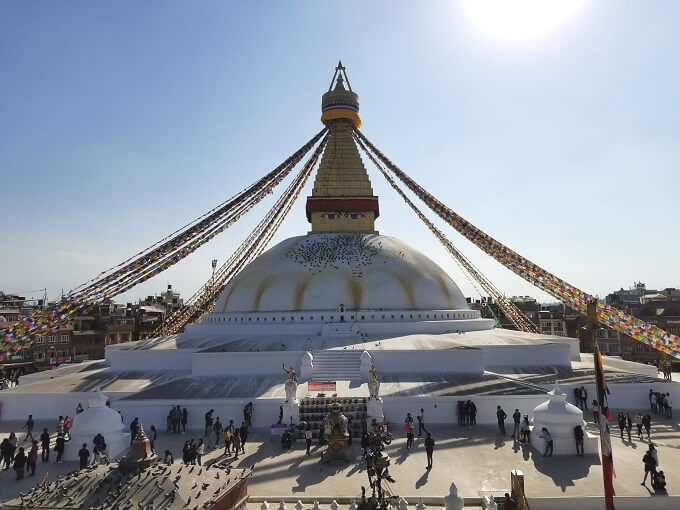
Today, the sacred place feels almost too commercialized by all the shops surrounding it. Still, there is something humbling as you circumambulate the stupa, small as a hummingbird in comparison.
The walk from Kathmandu to the Boudha Stupa is 4-5 kilometers, 50-65 minutes, depending on your starting point.
Once there, there is little enforcement around ticketing, just like many other sites in Kathmandu. But help the struggling city out as it continues its recovery, and pay for your 400 NPR ticket when you visit.
7. Fend off monkeys at Swayambhunath
Next, there’s Kathmandu’s famous Monkey Temple, or Swayambhunath.
Like the Boudha Stupa, Swayambhunath is an important site for Tibetan Buddhists. Besides tourists, you’ll also see many locals at both places circumambulating the stupas.


Depending on where in Kathmandu you start from, the walk there is between 2-5 kilometers, 30-65 minutes.
That’s an easy walk in the park compared to when you arrive at the Monkey Temple, where, well, there are a ton of monkeys.
Monkeys charging at people and swiping things out of their hands. Monkeys swarming people and overtaking the site. Monkeys humping each other with abandon.


Monkey here, monkey there, literally monkeys everywhere.
So, depending on your perspective on monkeys, the 200 NPR admission is either a fantastic opportunity to visit an important religious and cultural site that happens to come with dozens of primate companions, or it’s a bit of paid torture.
Pro tip: whether in Nepal, Bhutan, or another Buddhist country, make sure to visit religious sites in a clockwise manner.
Pro tip #2: there are 365 steps leading up to the stupa, so be prepared. You can also skip the climb if you enter the complex from the backside of the temple. That way, there are only a few dozen stairs.
8. Say hello at the monasteries
While you’re up at the Monkey Temple, make sure to stick around and visit nearby monasteries like Whochen Thokjay Choyaling Monastery.
While I spoke no more than 2-3 words in Nepali and they spoke no English, the monks and novice monks of the monastery were super friendly and inquisitive. Selfies all around!

9. Search for Kathmandu street art
As you walk to and from all these places, keep your eye out for some cool street art in unexpected places.
Hunting down street art is one of my favorite things when traveling. And while Kathmandu isn’t known for its street art, it still has some great contenders.
I’ll let the photos speak for themselves!






10. Observe locals at the temples
This last suggestion is perhaps one of the most fascinating things to do in Kathmandu.
In a city filled with Hindu and Buddhist temples by the hundreds, there is perhaps no easier way to get a glimpse of the local habits and customs than to observe the locals interacting with these temples.


Position yourself near a few Hindu temples throughout your stay, and watch the locals as they stop by or duck into the temples, say a prayer, ring a bell, paint a red sandalwood dot on their forehead, and then go about their day.
And find yourself near some Tibetan Buddhist stupas and prayer wheels and watch as believers circumambulate and spin the wheels.
If you feel up to it, find a local who can tell you more and maybe even share these traditions with you where appropriate.
Which of these things to do in Kathmandu intrigues you the most?
Pin it to share it!
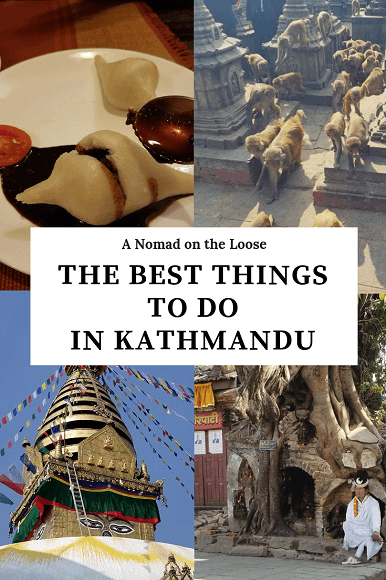

Nice post! I shared it with my cousin who has literally just arrived in Kathmandu. Thanks!
Thanks, Deano! Hope it’s helpful for your cousin!
Wow love the building throughout Kathmandu very pretty!
Thanks!
Those momos look delicious! I’ve always wanted to visit Kathmandu. Thanks for the recommendations.
You’re welcome! Hope you get to visit someday!
Great variety of things to do! For $1, I think ALL I’d do is eat Momos! Unfortunately my husband hates them. Seems like every city has at least a small street art scene these days, which makes me very happy as it’s one of my favourite things to seek out, as well. Some great pieces there!
What? Someone who hates momos? Ditch him! Jk ;)
Oh, I’ve been to Kathmandu twice, and during my last visit I spent quite a lot of time walking around different areas, I had more than a week without any plans after all, but I hadn’t heard of Patan Durbar Square. Must visit next time I’m there.
Hope you get to go next time you’re there!
[…] Bogota, no less safe than other major capitals like San Jose, Costa Rica or Kathmandu, Nepal […]
[…] spent two weeks in Nepal in December, which is considered low season. My time was spent between the capital of Kathmandu, trekking in the Annapurna mountain range, and relaxing in Pokhara, the jumping off point for […]
[…] the chaotic hustle and bustle of Kathmandu felt overwhelming to you, head west to […]